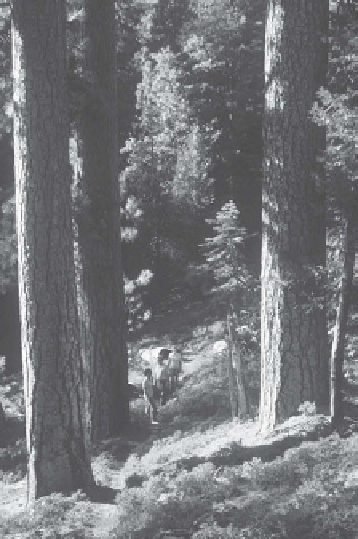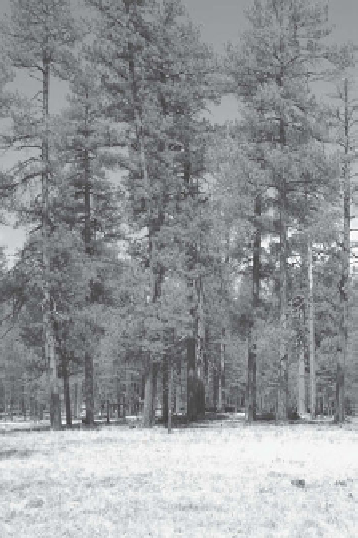Agriculture Reference
In-Depth Information
(a)
(b)
Fig. 5.6
Ponderosa pine
(Pinus ponderosa)
(a) illustrating self-pruning and thick bark, tall stature
with understory of
Chamaebatia foliolosa,
(b) with grass understory. (Photos by Jon Keeley.)
with high surface radiation that supports herbaceous understory fuels (
Fig. 5.6b
),
usually perennial grasses. On more mesic
A. concolor
dominated mixed conifer sites,
nearly complete canopy closure reduces light levels at the soil surface and limits
herbaceous growth. It has been suggested that this lack of a grass understory is the
result of fire suppression that has allowed the canopy to close in over the past century
and shade out grasses. However, this is not supported by historical studies showing a
lack of grass phytoliths in the soils of mixed conifer forests (Evett
et al.
2006
,
2007
). It
Surface fuels in the mixed conifer forest comprise dead needles and branches, which
accumulate rapidly due to the high productivity of these forests (
Fig. 5.7
).
Grasses in ponderosa pine forests maintain a continuous fuel cover that
enhances fire spread. In addition, these vertical fuels produce a high surface area
to volume ratio, and this packing ratio, plus the loose packing of long-needle
P. ponderosa
litter, enhances combustion. Since these forests have a relatively open
canopy, surface fuels are dry for longer periods beginning in late spring, they can
carry fire at short intervals, of 5 yrs or less.
In closed-canopy mixed conifer forests, dead surface fuels of needles and
branches are typically oriented horizontally and this, plus the very short needles
of
A. concolor
, results in a low packing ratio that inhibits combustion. In addition,


